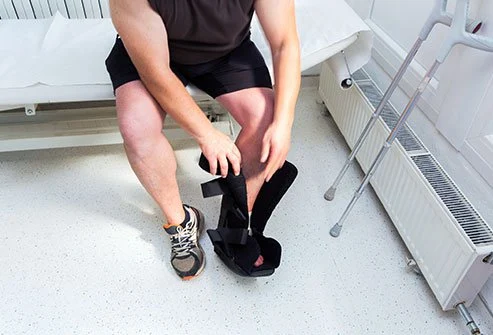
Can you walk with an ankle splint?
Share
Ankle splints can be used for sprains, fractures and dislocations. You may be able to walk with an ankle splint, but usually not right away.
After an injury such as a sprain, fracture, or dislocation, it usually takes time to heal before weight bearing. Walking or weight bearing prematurely may slow healing or cause further damage.
It is important to have your injury diagnosed and to speak with your doctor to know when you can walk with an ankle splint.

What is an ankle splint and what is it used for?
An ankle splint is an ankle immobilization device that is more flexible than a cast and allows room for swelling. A splint helps immobilize and protect an injured ankle, aid in healing, and reduce pain.
Ankle splints are used to treat abnormalities of the musculoskeletal system of the ankle, especially when swelling is expected. can use
What is a foot or ankle splint/brace?
A splint, sometimes called a "semi-cast," immobilizes your foot or ankle. They provide less support but have fewer complications than casts. Because they're quick and easy to apply, patients can get in and out of the doctor's office faster than they can get a cast. Plus, the splints/brackets are easy to loosen, tighten or remove using the Velcro straps that hold them in place. This allows the splint/bracket to adapt to any changes in foot or ankle swelling.
- Temporary fixation for sprains, fractures, reduced dislocations, severe soft tissue injuries and post-laceration repairs
- control pain and spasms
- reduce swelling
- Prevent further soft tissue or neurovascular damage associated with bruises, sprains, tears, fractures, dislocations or joint pain due to inflammatory diseases
Types of splints and braces
How to pick the correct ankle brace
There are several different types of splints. For your ankle, for example, your doctor may recommend a rear ankle, stirrup, or high-top walking boot splint. For your feet, you might get a rear ankle boot with a toe box, a high-top walking boot, or a hard-soled shoe. A doctor may use a splint instead of a cast to treat a foot or ankle injury. Alternatively, they may use a splint as a first line of defense to immobilize the limb after the injury and plan to reassess the foot or ankle 5 to 7 days later.
What to expect from a foot or ankle splint/brace
Your doctor provides you with ready-made splints. In some cases, you may need custom splints. The length of time you have to wear it depends on the extent of your injury. In most cases, patients wear a foot or ankle splint/brace for 4 to 8 weeks.
Your doctor will also give you instructions on how to care for your foot or ankle in a splint. Common instructions include keeping the splint clean and dry, raising the limb, and applying ice to reduce swelling and pain.
Common conditions requiring a foot or ankle splint/brace
Doctors use a splint to temporarily immobilize the foot or ankle. These devices can be used as a first step in treating fractures, and doctors plan to cast them later once the swelling has subsided. They can also be stand-alone treatments:
-
sprain
- fracture
- joint dislocation
- Serious soft tissue injury
- Protection of the foot or ankle after surgery
What are the complications of using an ankle splint?
Short-term splinting is generally recommended to maximize its benefits while avoiding complications. Complications of over-immobilization with continued splinting may include:
-
chronic pain
- joint stiffness
- muscle atrophy
- complex regional pain syndrome










